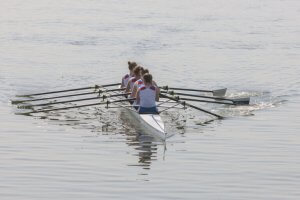History and Basics of Rowing: Competition Rules

Despite the fact that it dates back to ancient times, rowing as a sport is still in full force in the US and around the world. Young people love it because of the complex techniques and dynamics. Those who dream of succeeding will need to also make sure they know the rowing competition rules.
The main rowing competition rules guide professionals in official events. However, it’s not only about memorizing a list of requirements and rules. In fact, it’s also about differentiating techniques and concepts.
The first rowing competition rules
Rowing began as a way of moving in boats, rather than as a sport. Probably, all ancient civilizations participated in rowing. They needed to row to get food, move around, and survive overall.
However, the history of rowing as a sport begins in seventeenth-century Europe. Specifically, it started in England. For several years, only British knights practiced it, since it was considered a stately sport.
Only in the mid-nineteenth century, rowing crossed borders. Then, Spain, Portugal, and Argentina created their first clubs. At this time, the first rowing competition rules also started to develop.
At the end of the same century, the International Rowing Federation (FISA) was also founded. To date, this is the main body responsible for regulating and promoting the sport around the world. To do this, they ensure that the rowing competition rules are up-to-date with the changes in the sport and athletes.

Rowing techniques and their rules
Using new techniques and technologies in rowing has allowed this sport to change rapidly. Not only did the style change, but the construction and design of boats changed too.
To get an idea, the current Olympic rowing program has fourteen modalities. Men and women, light and heavyweights, follow their own specific set of rules.
On the other hand, there are many other modalities of competition rowing that are not Olympic and have their own rules. In addition, there are separate regulations for different boats and the type of “terrain” where the races take place.
Therefore, it’s impossible to talk about general rowing competition rules. However, there are some basic concepts that practically all competitions follow. Let’s look at some examples.
Basic concepts
First, you need to understand the official concept of rowing competitions. According to the rules, rowing competitions happen through a race in calm waters and straight courses. Therefore, in official competitions, the only variables that differentiate the modalities are the weight and specialties of the rowers.
Although the courses are posted, the rules don’t require boats to necessarily stay in their lane. In fact, boats just can’t interfere with each other during races. In addition, athletes must respect a minimum distance.
During official competitions, knockout, semi-finals and finals are usually held. Generally, the teams are divided into two or more groups. Usually, events last at least four days. Also, the number of groups and the duration vary depending on the number of crews.
Departure and arrival
The start of rowing competitions involves a ritual at the start. From the moment they announce, “Two minutes,” this person needs to make sure that all crews and judges are in their positions and ready to start the race.

Only after the judge names the crews one by one does the judge intervene to confirm or delay starting. If the judge gives the white light, the manager says, “Attention.” Then, a siren sounds and a mechanism releases the bow of the boats. This means that the race has started.
Arrival is a little easier. When the bow of the winning boat crosses the finish line, the siren sounds again. Likewise, the thirteen arrival judges will decide if there’s a photo finish to determine which crew is the winner.
To learn more about the rowing competition rules
On the FISA website, you can learn all about international rowing rules, events, and competitions. At the national level, you can check out the US rowing rules.
Despite the fact that it dates back to ancient times, rowing as a sport is still in full force in the US and around the world. Young people love it because of the complex techniques and dynamics. Those who dream of succeeding will need to also make sure they know the rowing competition rules.
The main rowing competition rules guide professionals in official events. However, it’s not only about memorizing a list of requirements and rules. In fact, it’s also about differentiating techniques and concepts.
The first rowing competition rules
Rowing began as a way of moving in boats, rather than as a sport. Probably, all ancient civilizations participated in rowing. They needed to row to get food, move around, and survive overall.
However, the history of rowing as a sport begins in seventeenth-century Europe. Specifically, it started in England. For several years, only British knights practiced it, since it was considered a stately sport.
Only in the mid-nineteenth century, rowing crossed borders. Then, Spain, Portugal, and Argentina created their first clubs. At this time, the first rowing competition rules also started to develop.
At the end of the same century, the International Rowing Federation (FISA) was also founded. To date, this is the main body responsible for regulating and promoting the sport around the world. To do this, they ensure that the rowing competition rules are up-to-date with the changes in the sport and athletes.

Rowing techniques and their rules
Using new techniques and technologies in rowing has allowed this sport to change rapidly. Not only did the style change, but the construction and design of boats changed too.
To get an idea, the current Olympic rowing program has fourteen modalities. Men and women, light and heavyweights, follow their own specific set of rules.
On the other hand, there are many other modalities of competition rowing that are not Olympic and have their own rules. In addition, there are separate regulations for different boats and the type of “terrain” where the races take place.
Therefore, it’s impossible to talk about general rowing competition rules. However, there are some basic concepts that practically all competitions follow. Let’s look at some examples.
Basic concepts
First, you need to understand the official concept of rowing competitions. According to the rules, rowing competitions happen through a race in calm waters and straight courses. Therefore, in official competitions, the only variables that differentiate the modalities are the weight and specialties of the rowers.
Although the courses are posted, the rules don’t require boats to necessarily stay in their lane. In fact, boats just can’t interfere with each other during races. In addition, athletes must respect a minimum distance.
During official competitions, knockout, semi-finals and finals are usually held. Generally, the teams are divided into two or more groups. Usually, events last at least four days. Also, the number of groups and the duration vary depending on the number of crews.
Departure and arrival
The start of rowing competitions involves a ritual at the start. From the moment they announce, “Two minutes,” this person needs to make sure that all crews and judges are in their positions and ready to start the race.

Only after the judge names the crews one by one does the judge intervene to confirm or delay starting. If the judge gives the white light, the manager says, “Attention.” Then, a siren sounds and a mechanism releases the bow of the boats. This means that the race has started.
Arrival is a little easier. When the bow of the winning boat crosses the finish line, the siren sounds again. Likewise, the thirteen arrival judges will decide if there’s a photo finish to determine which crew is the winner.
To learn more about the rowing competition rules
On the FISA website, you can learn all about international rowing rules, events, and competitions. At the national level, you can check out the US rowing rules.
All cited sources were thoroughly reviewed by our team to ensure their quality, reliability, currency, and validity. The bibliography of this article was considered reliable and of academic or scientific accuracy.
- Web oficial Fereración Internacional de Remo. Extraído de: http://www.worldrowing.com/
- Web oficial Fereración Española de Remo. Extraído de: http://federemo.org/
This text is provided for informational purposes only and does not replace consultation with a professional. If in doubt, consult your specialist.








